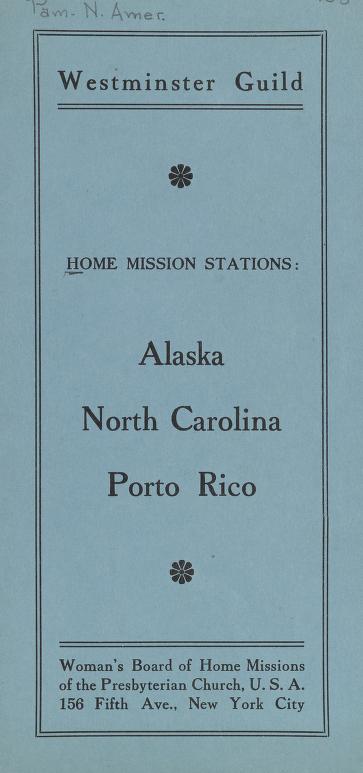

This pamphlet, which was the first of three pamphlets of this kind to be published in 1916, gives an overview of three missions in Alaska, North Carolina, and Puerto Rico. As the name and author of the pamphlet suggest, this publication was produced by the Presbyterian Church’s Women’s Board of Home Missions and therefore covers Presbyterian missionary work within the United States, like Alaska, North Carolina, and most importantly, Puerto Rico (Presbyterian Church in the USA Woman’s Board of Home Missions, 1). The entry included below specifically addresses the La Marina School in Mayaguez Puerto Rico. As explained on the first page of the pamphlet, the purpose of this publication is to update Presbyterian women about what is going on in each home missionary front.
This document was published in the United States by the Presbyterian Church and therefore reflects the beliefs of these institutions. Much like George Milton Fowles, the author of Down in Porto Rico, this pamphlet represents the perspective of American citizens who are critical of Puerto Rico and feel the need to better it. Throughout this source, readers can pick up on critical language used to describe the island and its inhabitants. Additionally, the authors use kind and generous language when describing the work of the missionaries and the church. For example, while the pamphlet says the Puerto Rican people are “afraid of fresh air” and even calls them immoral, but the authors mention how the missionary women are “accomplishing the regeneration of the community” and how “immorality [is] done away with.” (Presbyterian Church in the USA Woman’s Board of Home Missions, 11-12)
This primary source gives the perspective of how missionaries, specifically women in missionary work, viewed their work. By reading documents like this one, we are able to learn about why American missionaries felt the need to proselytize Puerto Rico and what skills and benefits Puerto Ricans might gain from this interaction as well. Additionally, although these women do not see their work as directly extending the American Empire, their work can still be understood in this context. In short, it is important to try and understand differing historical perspectives in order to understand the complex interplay of people, governments, and religion.
“If we wish to visit ‘La Marina’ School without crossing the Islands, we would have to leave the steamer six hundred feet out and go ashore in a small boat, since there is no dockage at Mayaguez on the western end of Porto Rico. We note the beauty of the place ‘with the sea at its feet and the mountains rising beautifully green behind it.’ The twenty thousand inhabitants could enjoy almost perpetual sunshine in this tropical climate but they seem afraid of fresh air and keep themselves closely shut up in poor, illy-ventilated houses. Our “La Marina” day school is located in the most crowded part of the town, down by the seashore, as its name signifies. Miss Clara E. Hazen, its principal, is doing a wonderful work and is accomplishing the regeneration of the community. The streets were very noisy, but the coming of a Christian Mission has brought quiet. The stores are now closed on the Sabbath. In the town are cheap moving pictures, but by the use of its stereopticon the Mission is trying to interest some of the people in a better class of pictures.
We might divide the work done at “La Marina” under four headings : ( 1 ) school work ; (2) day nursery; (3) vacation school; (4) industrial work. The regular work in the day school carries pupils through the fourth grade. The day nursery has been opened by the Auxiliary — American ladies resident in Mayaguez. The vacation school keeps boys and girls happily and profitably employed for eight weeks in the summer. Of especial interest is the industrial work. Basketry is taught, but more important than this, the fine embroidery and drawn work done in old Spanish times. Women who had learned this beautiful work were asking for an opportunity to teach it that they might earn thereby bread for themselves and their children. Young girls who had inherited an aptitude for such work were begging to be taught. This fine art is now taught by a Spanish teacher to a group of working girls from fifteen to twenty-one years of age who could not remain in school to prepare themselves for teaching, but needed to earn their own living. In this class they are kept in the mission atmosphere and yet enabled to earn money, for their work is paid for as soon as it is salable.
Miss Hazen has associated with her two native helpers from the Colegio Americano, girls who were trained in the class formerly supported by the Westminster Guild. A daily Bible Class is conducted for all pupils in the school. The Christian influence is being shown in the lives regenerated — immorality done away with, quietness in homes and on the streets, cleanliness, and in fact all the marks of Christian life that are present where His Gospel is preached. The Westminster Guild is helping to Christianize this western end of Porto Rico through sharing in this work of regeneration at the Marina Mission.” (Pages 11-12)
Sources
Presbyterian Church in the USA Woman’s Board of Home Missions. “Home mission stations: Alaska, North Carolina, Porto Rico.” Columbia University Libraries. March 1916. \https://archive.org/details/ldpd_11375195_000/page/12/mode/2up.